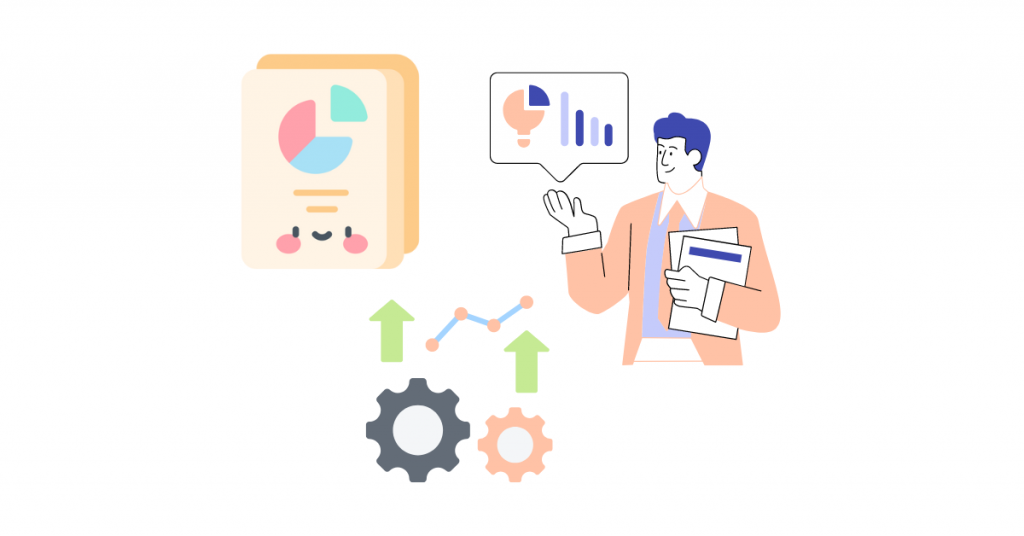Managing product information effectively has become a crucial factor for businesses to thrive in the era of digital commerce. Product Information Management (PIM) systems have emerged as a game-changer, helping businesses streamline data management, enhance customer experience, and stay ahead in the competitive landscape. But what exactly is PIM, and how does it impact your business? In this blog post, we will explore the ins and outs of PIM, its role in digital commerce, the key features of effective PIM software, and how to choose the right solution for your business. Let’s dive in!
Overview
- Product Information Management (PIM) is a system designed to centralize product data, improve customer engagement, and streamline workflows.
- PIM solutions offer centralized platforms for improved data management, collaboration between departments and enhanced customer experience.
- Case studies have demonstrated the advantages of incorporating a PIM solution, including increased accuracy, efficiency, and business performance.
Understanding Product Information Management (PIM)

Product Information Management (PIM) is a system designed to manage product data in a centralized manner, facilitating marketing and sales across multiple channels. PIM systems have the following features:
- They aggregate product data from all distribution channels into a single, unified source.
- They are a part of master data management.
- The primary purpose of PIM is to unify product content requirements and distribute superior product information to sales and marketing outlets.
PIM is a crucial aspect of product data management.
By leveraging PIM systems, businesses can experience faster time to market, increased brand loyalty, improved operational efficiencies, better product data quality, and a more engaging omnichannel product experience that ultimately leads to increased sales velocity. PIM features include custom pricing upon request, localized and regionalized information, pictures, videos, marketing materials, supplier, inventory, and category data, analytics, and the ProductXM—product experience management platform.
The role of PIM in digital commerce
In the realm of digital commerce, PIM systems play a vital role in managing all the data related to product information, digital assets, and marketing content, enabling businesses to provide a consistent customer experience across multiple platforms. The primary purpose of PIM is to author product data for publication to sales channels, such as eCommerce websites or print publishing systems.
Product marketers can use a PIM and DAM solution to:
- Request and assign copywriting, photography, and videography services for their new products
- Better manage the content creation process for all their products
- Attach the most suitable copy and digital assets to the master product listing within a PIM system
- Integrate with customer relationship management (CRM) systems to enhance customer experience.
In essence, PIM systems provide the ability to edit and manage product information from a unified interface and disseminate product information to all relevant parties, ranging from internal operations to suppliers, manufacturers, wholesalers, and customers across sales and eCommerce channels.
Components of a PIM system
The primary purpose of a PIM system is to serve as the authoritative source of product information, from which other systems can retrieve data. This leads to significant business benefits, such as improved data management, streamlined workflows, and enhanced customer experience.
A PIM system is designed to store and manage all details related to products, such as technical specifications, category information, content, metadata, and other related data variants. A PIM system comprises storage and sharing components for product information, customized data attributes for different product types, automation tools for workflow facilitation, cloud-based integrations, optimization for search engine optimization (SEO), and ingestion and storage of product content.
Collectively, these components ensure a smooth flow of product information throughout the organization, enhancing overall business operations.
How PIM solutions improve business operations

Implementing PIM solutions can facilitate collaboration between departments, ensure data accuracy, and optimize workflows. By providing a centralized platform for product information management, PIM allows businesses to improve data management, seamlessly integrate and deliver data, offer relevant product recommendations for customers, streamline collaboration and transparency, and enhance employee experience while reducing data entry errors.
All these benefits contribute to an improved customer experience, resulting in increased sales and a strengthened brand reputation.
Enhancing collaboration between departments
PIM systems can be beneficial for departments’ collaboration by providing a single source of truth for product information, thereby diminishing errors and discrepancies. By offering a centralized source of product information, PIM solutions limit potential errors and inconsistencies between departments, ensuring smooth communication and collaboration throughout the organization.
This centralized approach not only streamlines internal processes but also fosters a culture of cooperation and transparency, leading to improved efficiency and overall business performance. In a world where cross-functional collaboration is essential for success, PIM systems play a vital role in breaking down departmental silos and facilitating seamless information sharing.
Ensuring data quality and consistency
PIM solutions guarantee data quality and consistency by automating data validation processes and furnishing tools for data enrichment. By providing a centralized platform to amalgamate and supplement product information, PIM ensures that product data is orderly, precise, and updated across channels.
Employing PIM solutions for data quality and consistency ensures that product data is precise, current, and consistent across all channels. This assists in diminishing product returns, fostering customer loyalty, and enhancing the overall customer experience.
Key features of effective PIM software
Effective PIM software should be capable of integrating with existing systems, customizable to suit the specific requirements of a business, and adaptable to changing needs. By possessing these core characteristics, PIM software can potentially facilitate collaboration between departments, guarantee data accuracy and uniformity, and integrate with existing systems, making it an indispensable tool in today’s digital commerce landscape.
PIM software can help businesses streamline their processes, reduce costs, and increase efficiency.
Integration with existing systems
PIM software is capable of integrating with a range of existing systems, including:
- eCommerce platforms
- ERP systems
- CRM
- Point-of-sale (POS) systems
- Warehouse management systems
- Inventory systems
Integration aids in improving the management and consistency of product data by ensuring that all product data is kept up-to-date and accurate across all systems through effective data governance.
Integration facilitates the streamlining of processes by eliminating manual data entry and decreasing the requirement for manual data reconciliation. Furthermore, integration ensures that all product data is up-to-date and accurate, thereby improving data accuracy and reducing redundancy.
Customizability and adaptability
Customizability and adaptability refer to the capability of a software solution to be tailored and adjusted to fulfill the particular needs and requirements of a business. By offering these features, PIM software allows businesses to customize the solution to their particular needs and requirements, making it more user-friendly and efficient.
Some examples of customizability and adaptability include the capacity to incorporate or remove features, personalize user interfaces, and integrate with other systems. Customizability and adaptability in PIM software offer businesses the ability to customize the solution to their specific needs and requirements, thereby making it easier to use and more efficient.
PIM vs other data management solutions
PIM is a specialized data management solution that differs from other solutions such as MDM and DAM. While PIM focuses on managing product information for marketing and sales purposes, MDM manages a wider variety of company information, including customers, suppliers, and financials.
DAM, on the other hand, is specialized in digital asset management.
PIM and MDM
PIM primarily focuses on managing product information for marketing and sales objectives, whereas MDM covers a broader scope of corporate data, such as customers, suppliers, and financials. This distinction highlights the unique role that PIM plays in the data management landscape, as it is specifically tailored to address the needs of businesses in managing product information across various channels and platforms.
On the other hand, MDM systems aim to provide a comprehensive data management solution that encompasses various types of data across an organization. Although both PIM and MDM systems share similar goals of ensuring data accuracy and consistency, their areas of focus and application differ significantly.
PIM and DAM
Digital Asset Management (DAM) systems assist organizations in organizing and controlling digital assets, including images, videos, and audio files. While PIM focuses on product data and marketing descriptions, DAM deals with the management of digital assets that often accompany product information.
PIM can be integrated with DAM systems to provide a comprehensive data management solution. By combining the capabilities of both PIM and DAM, businesses can:
- Streamline their data management processes
- Foster collaboration between departments
- Guarantee data quality and consistency
- Improve the customer experience
The Impact of PIM on customer experience

PIM has a considerable influence on customer experience by providing consistent and reliable product information, minimizing the risk of mistakes or inconsistencies. PIM also enables businesses to customize product information based on customer preferences, augmenting the applicability and efficacy of marketing and sales endeavors.
Moreover, PIM expedites time-to-market for new products and updates, enabling businesses to quickly respond to customer demands and preferences. PIM plays a critical role in improving the customer experience and stimulating customer satisfaction.
Reducing product returns
By offering comprehensive product descriptions to customers, PIM helps ensure that they purchase the correct products, thus minimizing product returns. Additionally, PIM centralizes and enriches product data, leading to an increase in sales and a decrease in customer return rates.
Decreased product returns can result in cost savings in terms of diminished shipping expenses, restocking charges, and customer service costs. By providing accurate and up-to-date product information to customers across all channels, PIM solutions contribute to fewer product returns, resulting in cost savings and improved customer satisfaction.
Building brand loyalty
PIM facilitates the provision of consistent and reliable product information across channels, thus promoting trust and loyalty with customers. Additionally, PIM allows businesses to customize product information according to customer preferences, thereby fostering loyalty by delivering pertinent and tailored product information.
By ensuring a seamless and engaging customer experience, PIM solutions help build brand loyalty, leading to increased sales and repeat business. In a competitive market landscape, businesses that prioritize customer experience by leveraging PIM solutions can distinguish themselves and build lasting relationships with their customers.
Choosing the right PIM solution for your business
Choosing the right PIM solution for your business involves evaluating different options and considering factors such as integration capabilities, customizability, and scalability. By taking these factors into account, businesses can select a PIM solution that best aligns with their unique needs and requirements, ensuring a seamless and effective implementation.
The evaluation process should include a thorough review of the features and capabilities of each PIM solution.
Evaluating different PIM options
Businesses should evaluate various PIM options, including SaaS, open-source, and custom-built solutions, to determine the best fit for their needs. Each option has its pros and cons; SaaS solutions offer scalability and user-friendliness, but may have limited customization capabilities.
Open-source solutions provide flexibility and cost efficiency but may lack support and have complexity in implementation. Custom-built solutions offer tailored features and control over the system but can be expensive and time-consuming to implement.
Factors to consider when selecting a PIM
When selecting a PIM solution, it is important to consider the following factors:
- Ease of integration with existing systems: This ensures smooth data sharing across multiple systems and eliminates the need for manual data entry, guaranteeing data accuracy.
- Customizability to meet specific business needs: The PIM solution should be flexible enough to adapt to your unique business requirements and workflows.
- Scalability to support potential future growth: As your business expands, the PIM solution should be able to handle increased data volumes and accommodate new product lines or channels.
Considering these factors will help you choose a PIM solution that best fits your business needs.
Customizing a PIM to satisfy individual business requirements can guarantee that the system is adapted to the particular needs of the business, making it more straightforward to utilize and more productive.
Scalability provides a business with the capacity to accommodate future growth, ensuring that the PIM system can manage increased data volumes and complexity.
Case studies: Successful PIM implementation
Multiple case studies of successful PIM implementation have indicated the advantages of incorporating a PIM solution, such as enhanced collaboration, data accuracy, and customer experience.
These examples demonstrate how adopting a PIM solution can lead to significant improvements in business operations and overall performance.
Wrapping up
In conclusion, Product Information Management (PIM) systems have emerged as a powerful tool for businesses to manage product data effectively in today’s digital commerce landscape. By implementing a PIM solution that integrates seamlessly with existing systems, offers customizability and adaptability, and ensures data quality and consistency, businesses can reap the benefits of improved collaboration, streamlined workflows, and enhanced customer experience. By choosing the right PIM solution and leveraging its capabilities, businesses can stay ahead in the competitive market and build lasting relationships with their customers.
Frequently Asked Questions
What does a product information manager do?
As a product information manager, one is responsible for the organization and delivery of accurate product data to customers through multiple channels. This involves managing and maintaining the data within a PIM system.
What is an example of Product Information Management?
An example of Product Information Management (PIM) is collecting, managing, enriching, and distributing product content to sales and eCommerce channels.
PIM also involves managing product data, digital assets, and various media files.
What is PIM and why is it important?
PIM, or Product Information Management, is a system that helps eCommerce businesses collect, enrich, and store product information in one place, creating a single source of truth for product data and aligning all teams and departments around a shared platform.
This system helps streamline processes, reduce errors, and improve the customer experience. It also helps businesses save time and money by eliminating manual data entry and ensuring data accuracy. With PIM, businesses can easily manage product information, create product catalogs, and keep product data up-to-date.
What is a PIM specialist?
A PIM specialist is responsible for managing the product data within an organization to support a multichannel marketing strategy. They work as part of a team to collect, maintain, and syndicate this data through the PIM system.
The PIM system is a powerful tool that helps organizations manage their product data more efficiently and effectively. It enables them to create, store, and share product information across multiple channels, such as websites.
How does PIM software integrate with existing systems?
PIM software integrates seamlessly with eCommerce platforms, ERP systems, CRM, point-of-sale systems, warehouse management systems, and inventory systems, making it a versatile solution for companies.
It can help streamline processes, reduce costs, and improve customer experience. It can also help companies manage product data more efficiently and accurately, ensuring that customers have access to the most up-to-date information.
In the dynamic world of Product Information Management (PIM) in 2023, your knowledge is your greatest ally. Stay informed, innovate, and keep ahead. If you ever need guidance or support, reach out. Here’s to a successful future in PIM!


Share on: